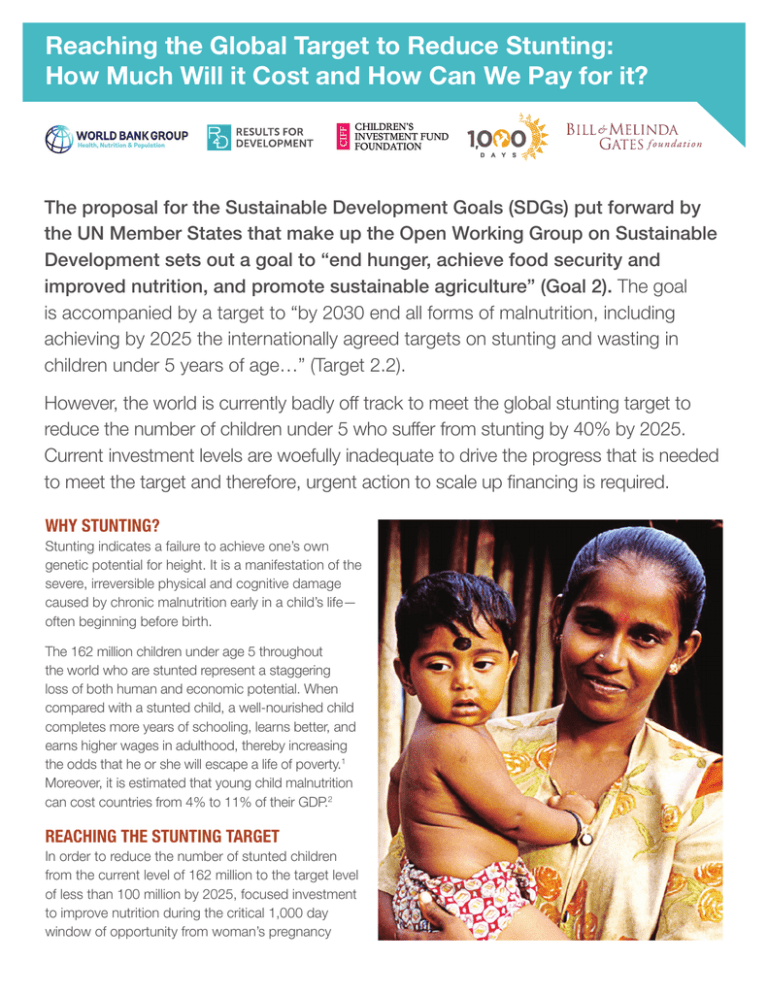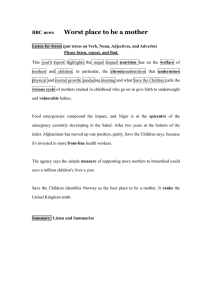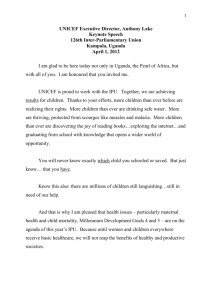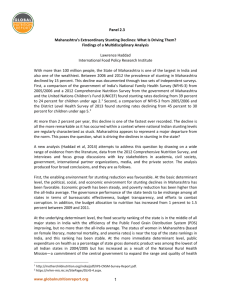Reaching the Global Target to Reduce Stunting: How Much Will it
advertisement

Reaching the Global Target to Reduce Stunting: How Much Will it Cost and How Can We Pay for it? The proposal for the Sustainable Development Goals (SDGs) put forward by the UN Member States that make up the Open Working Group on Sustainable Development sets out a goal to “end hunger, achieve food security and improved nutrition, and promote sustainable agriculture” (Goal 2). The goal is accompanied by a target to “by 2030 end all forms of malnutrition, including achieving by 2025 the internationally agreed targets on stunting and wasting in children under 5 years of age…” (Target 2.2). However, the world is currently badly off track to meet the global stunting target to reduce the number of children under 5 who suffer from stunting by 40% by 2025. Current investment levels are woefully inadequate to drive the progress that is needed to meet the target and therefore, urgent action to scale up financing is required. WHY STUNTING? Stunting indicates a failure to achieve one’s own genetic potential for height. It is a manifestation of the severe, irreversible physical and cognitive damage caused by chronic malnutrition early in a child’s life— often beginning before birth. The 162 million children under age 5 throughout the world who are stunted represent a staggering loss of both human and economic potential. When compared with a stunted child, a well-nourished child completes more years of schooling, learns better, and earns higher wages in adulthood, thereby increasing the odds that he or she will escape a life of poverty.1 Moreover, it is estimated that young child malnutrition can cost countries from 4% to 11% of their GDP.2 REACHING THE STUNTING TARGET In order to reduce the number of stunted children from the current level of 162 million to the target level of less than 100 million by 2025, focused investment to improve nutrition during the critical 1,000 day window of opportunity from woman’s pregnancy FIGURE 1 162 million children under 5 stunted in 2013 Global target: reduce to ~100 million by 2025 85% of stunting concentrated in 37 countries through a child’s 2nd birthday is urgently required. Efforts to improve nutrition during this critical window must also be intensified in countries where the burden of stunting is greatest. While globally, 1 in 4 children under the age of 5 is stunted, the vast majority of them live in Sub-Saharan Africa and South Asia (Figure 1). supplementation and the provision of nutritious complementary foods. In aggregate, it is estimated that the total additional investment required to scale up this package of interventions is $49.6B over the next 10 years, with smaller annual investments in the first 5 years and increasing gradually as coverage increases. WHAT IT WILL COST FIGURE 2 The World Bank, Results for Development Institute (R4D), and 1,000 Days, in partnership with the Bill & Melinda Gates Foundation and the Children’s Investment Fund Foundation, have estimated that it will cost approximately an additional $8.50 per child per year to meet the global stunting target (Figure 2). This cost covers the scale-up of high-impact, proven interventions focused in the 1,000 day window— namely, improving maternal nutrition; improving infant and young child feed practices, which include exclusive breastfeeding for the first 6 months of life; and improving child nutrition through micronutrient Annual additional cost per child under 5 $8.50 2 THE IMPACT OF INVESTING IN MEETING THE STUNTING TARGET CURRENT INVESTMENTS IN STUNTING REDUCTION There is strong and growing consensus that improving young child nutrition is one of the best investments a country can make in its future prosperity. According to recent estimates, $1 invested in stunting reduction generates about $18 in economic returns.3 Despite the overwhelming evidence of the economic impact of reducing young child malnutrition, both domestic and donor contributions to improving nutrition have been inadequate and slow. Based on the limited data available for the 37 countries that account for the majority of the world’s stunting burden (Figure 1), an estimated $2.9B is currently being spent annually by country governments, donors, and households on the identified package of interventions targeted toward stunting reduction. Of this amount, governments invest $1.6B, donors contribute only $0.2B, and households add an estimated $1.1B in out-of-pocket spending on complementary foods and supplements per year (Figure 4). The modest additional investment of $8.50 per child under 5, if sustained over 10 years alongside existing investments and projected improvements in the underlying determinants of malnutrition (growth in per capita GDP and improvements in food availability and diversity, women’s health, education, and empowerment), would enable countries to achieve significant reductions in stunting. By 2025, about 74 million children would escape the scourge of stunting and its impacts, and be able to fully contribute to growing their families’ income and their national economies (Figure 3). FIGURE 3 Cost and impact on child stunting MILLIONS OF STUNTED CHILDREN UNDER 5 175 162m stunted Underlying determinants of stunting* 150 125 100 Reducting stunting by 40% by 2025 ~74 million fewer children stunted in 2025 Nutrition-specific interventions ~100m stunted 75 2016 2017 2018 2019 2020 $15.6 billion required for 2016-2020 2021 2022 2023 2024 2025 $34.0 billion required for 2021-2025 *Includes per capita GDP, food availability and diversity, and women’s education, health, and empowerment 3 BUSINESS AS USUAL WILL NOT SUFFICE FIGURE 4 There is a significant gap between what is needed to achieve the target and what is currently spent. When the costs of scaling up the package of targeted interventions are compared to the estimated domestic, household, and donor resource flows over the next 10 years, it is clear that the global target to reduce the number of stunted children by 40% will not be met (Figure 5). Estimated spending for general nutrition and for stunting reduction interventions in high burden countries, 2015 ($USD billions) Total $4.7 Other interventions Costed stunting interventions $1.8 COMMITMENTS TO FINANCING GROWTH ARE NEEDED Total $2.9 Reaching the global target will require greater commitment from countries and donors, and a global prioritization and harmonization of nutrition investments. The funding gap that currently exists can be closed through a coordinated effort to mobilize additional resources from national governments, traditional donor assistance, and new innovative financing mechanisms such as the Power of Nutrition Fund and the Global Financing Facility (GFF). In this “global solidarity” scenario (Figure 6), high burden countries progressively increase nutrition spending from now to 2020 as a share of general government $1.4 $2.9 Total – all sources Total $1.1 $1.6 Total $0.6 $0.4 Domestic Donor $1.1 Household contributions Sources: National budgets; SPRING4; Save the Children; CRS database (2013) basic nutrition disbursements were projected to 2015 based on OECD reported growth projections FIGURE 5 Continuing business as usual and financing stunting interventions solely through increases in economic growth will be insufficient to close the resource gap. Business as usual scenario financing projections Remaining gap 8.6 Additional household 8.8 8.9 3.7 3.6 3.5 0.8 0.9 1.0 0.7 7.5 Additional domestic Additional donor 6.5 Baseline 5.6 4.6 3.8 9.0 8.7 1.7 3.1 2.3 1.0 2.9 3.8 0.5 0.6 3.4 0.5 0.6 0.8 0.9 1.1 1.2 1.3 1.4 2.9 2.9 2.9 2.9 2.9 2.9 2.9 2.9 2.9 2.9 2.9 2015 2016 2017 2018 2019 2020 2021 2022 2023 2024 2025 4 expenditures to the median level of their income group (ability to pay), while donors and innovative funding initiatives pick up the balance of financial requirements. From 2021-2025, the countries further take on part or all of the funding being covered by donors, depending again on their income group. Under this scenario, over the next 10 years, high burden country governments would mobilize an additional $18B, while traditional donor aid would contribute $15.8B, and innovative sources such as the Power of Nutrition and the GFF would account for another $3.6B. Responsibility for the extra funding is thus shared fairly and sustainably between low- and middle-income countries and donors. On average, countries are required to increase their share of government health spending for nutrition from less than 1% to 4%, while donor funding for stunting reduction peaks at 4% of estimated Official Development Assistance in 2021 and tapers after that. GLOBAL SUCCESS IS POSSIBLE Past experience shows that it is possible to dramatically accelerate and sustain funding to lower stunting by 40% over a decade. Between 2001 and 2011, the global AIDS movement saw funding for prevention and treatment grow from less than $0.5B to over $15B—a rate of expansion greater than what is needed to scale up programs to reduce stunting. With a combination of cost-effective interventions, political will, widespread advocacy, and smart investments, ending child malnutrition within a generation is possible if the global community truly comes together to accelerate and sustain financing and action. FIGURE 6 The Global Solidarity scenario illustrates how the stunting resource gap can be closed through fair and sustainable burden sharing between countries and donors. Global Solidarity scenario financing projections ($USD billions) Innovative souces 8.6 8.7 8.8 8.9 9.0 0.6 0.7 0.8 0.9 1.0 2.0 2.3 2.7 3.0 3.3 2.3 2.0 1.7 Additional household 7.5 Additional domestic Additional donor 6.5 Baseline 5.6 2.9 0.6 1.6 1.2 4.6 3.8 0.5 0.9 0.8 1.0 1.6 2.1 2.6 1.3 2.9 2.9 2.9 2.9 2.9 2.9 2.9 2.9 2.9 2.9 2.9 2015 2016 2017 2018 2019 2020 2021 2022 2023 2024 2025 CITATIONS artorell et al. 2010. Weight gain in the first two years of life is an Important of schooling outcomes in pooled analysis from 5 birth cohorts from low- and middle-income countries. Journal M of Nutrition. 140:348-54. Hoddinott et al. 2008. Effects of a nutrition intervention during early childhood on economic productivity in Guatemalan adults. Lancet. 371:411-16. Hoddinott, J., J. Maluccio, J. R. Behrman, R. Martorell, P. Melgar, A. R. Quisumbing, M. Ramirez-Zea, A. D. Stein, and K. M. Yount. 2011. “The Consequences of Early Childhood Growth Failure over the Life Course.” Discussion Paper 1073. International Food Policy Research Institute, Washington, DC. 2 Horton S. and R. Steckel. 2013. “Global Economic Losses Attributable to Malnutrition 1900–2000 and Projections to 2050.” In The Economics of Human Challenges, ed B. Lomborg. Cambridge, U.K.: Cambridge University Press. 3 Hoddinott, Alderman, Behrman, Haddad, & Horton (2013). The economic rationale for investing in nutrition. Maternal and Child Nutrition 9(Suppl. 2): 69-82. Median estimate for a sample of 17 high burden countries used by the authors. 4 SPRING. 2015. “Uganda Nutrition Financing Discussion Guide FY 2013/14.” Internal report. Arlington, VA: USAID/Strengthening Partnerships, Results, and Innovations in Nutrition Globally (SPRING) Project. 1 5



